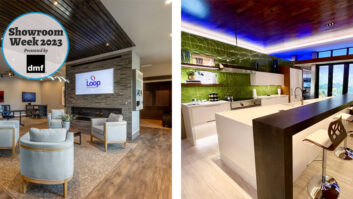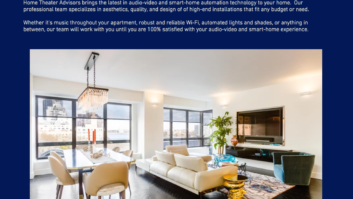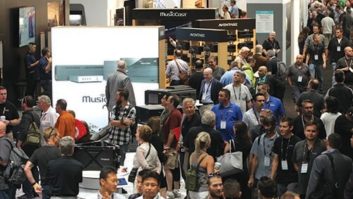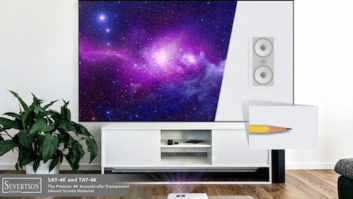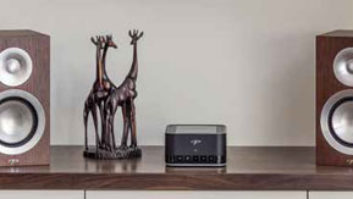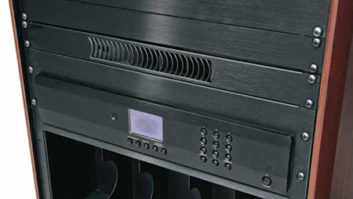Heres a pop quiz for installers: How has the digital music playernotably the iPod, but also its herd of competitorschanged your life?
A. Not at all
B. Maybe it will change my life, but it has not done so yet
C. Its giving consumers a larger sense of entitlement about the ease of use and the comprehensiveness they expect from entertainment devices.
A consumer looks at the digital music player fitting comfortably in the palm of his or her hand and starts to wonder, if I can hang my entire music library on my belt loop, why cant I make it available throughout my home? Making this possible is not new and certainly something installers can do. What is new, however, is the stronger demand from customers to whom the iPod has given a sense of entitlement.
Consumers are becoming more assertive about what they want even if they rarely understand the technology behind the answer. They want systems with compatible hardware that make it possible to obtain content from any number of sources including CDs or music downloads, video and, increasingly, satellite radio. In addition to being able to enjoy it throughout the home, consumers want to be able to take this same content with them on the road via their iPods or portable digital media players, and/or cellular phones.
But you probably know your customers better than they know themselves. While they say they want to be dazzled by gee-whiz technology, you know from experience that what they really want is to feel comfortable with reliable and easy-to-use devices. That will ensure themand youpeaceful nights. Most of your customers are not early adopters like you. For you, it is a business imperative to see as quickly as possible whether a solution fails or is a step on the road to success or, most rarely, is a homerun.
How do you install the digital home, complete with the latest and best automation and entertainment technology, with the confidence that it has been tested and will be around for awhile? A number of trends suggest that the digital home market is about to take off with demand escalating just in time for holiday season 2005. At the same time, developments related to Microsofts Windows XP Media Center Edition 2005 indicate it may be on the verge of a catching hold when it comes to offering the convenience and reliability that truly makes good business sense.
Microsofts first two versions of Media Center failed to result in PC-centric home theaters popping up in every home on the block. However, each version was a success in whetting the appetite for more. Bill Gates has said that Media Center Edition 2005 moves the product into the mainstream. And although his forecast might be self-serving, this version is universally viewed as an improvement over earlier ones. The Media Center PC, configured to play the role of several CE devices including a DVD player, digital VCR, stereo and TV, now offers better video recording and playback capabilities. Its ready for its close-up, or more to the point, its ready to be projected on an expensive, high-definition screen in living rooms and family rooms.
Microsoft is using a familiar pattern to achieve a commanding position in a market. Meticulous and methodical prepping is followed with a blitzkrieg of marketing and public relations. Accordingly, Microsoft began this spring to showcase the possibilities of Media Center 2005 in model digital homes in major metropolitan areasdoubtless one will open in your city soon, if it has not already happened. The U.S. showcase is actually the second wave; demonstrations of digital homes featuring Media Center 2005 have already been underway in the U.K.
As part of its preparation of the market, Microsoft is also lobbying to have Windows Media adopted as a broadcast TV standard for distributing content. Microsoft has long partnered with Intel to realize the vision of the digital home in the convergence of PC and CE. In Intels Digital Homes Consumer Electronics Group, Glenda Dorchak, vice president and general manager, has noted, Interoperability is key to the growth of consumer electronics devices, broadband content consumption, networking and services in the digital home. A number of hardware partners are lined up with Microsoft, including Dell, Gateway, HP, Sony, and Toshiba. And various digital media partners, including America Online, Atari, and CinemaNow, have also joined in.
Microsoft is working with such major retail players as Tweeter to cultivate the consumer grassroots, stimulating awareness and demand for digital solutions that wed PC with CE. Microsoft is also using its retail connections to build a bridge to installers who can deploy blended PC/CE solutions. Installers are a fragmented group, but Media Center Edition is serving as a catalyst to draw them together around a product that enhances their ability to respond to the marketplace. Best Buy, which has one of the strongest grips on the consumer mainstream, is using Microsoft to help recruit custom installers under its banner. Installers benefit from the combination of the retailers brand image and the promise of Media Centers capabilities.
An earlier deterrent to the adoption of PC-centric home entertainment has been the concern that such solutions would be difficult to use. This concern has faded with the rise of popular products that use browsers, including PDAs, PocketPCs, and cell phones, as well as personal computers.
Intuitive to use, browser-based is becoming the preferred interface. Such devices also give consumers new capabilities and power that makes the PC-centric home entertainment systems all the more attractive. All of these devices can be used in controlling systems in the home through a server like those offered by such companies as HomeSeer. The server may be accessed from within the house or remotely from anywhere in the world.
Media Center Extenders, set-top boxes, can be placed in another room in order to access the Media Center computer. The Extenders enable recording and playback of different material in each room. Several programs can be watched and/or recorded simultaneously using the same Media Center PC.
Installers are also finding that product improvements make it easier to find devices that work and work together. For example, last year four companies joined to create Digital Home in a Box, which brings together components guaranteed to work in concert to install a digital solution. Available from Worthington Distribution, the box includes products from Global Cach, HomeSeer, and Pelham Sloane.
Products improvement, along with increasing consumer savvy and a push by Microsoft, suggest that installers may be on the verge of new business opportunities in a market for installing digital homes. Perhaps no other company can put time and money behind a product to ensure success in the way that Microsoft can. However, its massive commitment, even when multiplied by that of its many partners, is no guarantee in itself.
As digital content increases, the middle market is seeing a different value propositionthat of leveraging a single investment to manage digital content, automate the home, and automate the family. Unlike the middle market, the upper-tier purchaser has traditionally been willing to install separate and proprietary solutions that manage the home entertainment, security, and other systems. The purchasers of control products from companies such as Crestron and AMX expect to pay a premium and are delighted with the products superb service and reliability. The homeowners who have always sought these products will probably continue to do so as, similarly, purchasers of high-end automobiles continue to seek them, even as they recognize that any number of middle-priced autos offer exceptional reliability and service, too.
The Media Center PC can mean substantially lower costs for the homeowner over installing a proprietary system, thus opening the market to a (large) new group of middle-income purchasers. These purchasers appreciate the value of a PC that can act as server while also being a family computer. Not only can it serve as a stereo and DVR piped into several rooms of the home, it can also control the homes lighting, electricity, security, and other systems. The versatility afforded by a PC-based home entertainment system is a value that makes all the difference to a large segment of middle-income buyers, while at the same time meaning little or nothing to the upper-tier buyers. As a result, Microsoft is already witnessing demand among the installer base for its products as dealers see the potential for the creation of customers.
But to pull off a variety of roles effectively in the home, the PC needs to be unobtrusive and quiet. Looks do, indeed, matter because who wants a clunky, noisy machine in the center of the living room or family room or in the kitchen? The entry of the all-in-one computer that dispenses with the tower makes the PC-centric home entertainment system, along with other home automation, more feasible for middle-income homes. A PC that fits flexibly, and even attractively, in a home makes a system far easier to sell. Middle-class homeowners are already thinking of how nice it would be a home entertainment center, and now to have something easy to use and attractive, taking the next step is easy.
Media center-equipped PCs and a growing host of compatible devices are making it easier to tap into the lucrative market of installing digital homes. As we face the holiday season at the end of this year, it looks increasingly as if this is the year that we will witness a major upswing in purchases. For installers, the question is whether you are ready to push your customers to take that final step. If you are not, someone else probably will.
Chris Miller is vice president of marketing at Pelham Sloane Inc. in Shelton, Connecticut.
